|
MOD - Creating a star 0.980
|
|
| Zefnoly | Date: Wednesday, 17.02.2016, 16:02 | Message # 61 |
 Space Tourist
Group: Users
 Pirate
Pirate
Messages: 38
Status: Offline
| This is just weird... Not even your "ZendaSys" script works... The star is there but not the planets from the script. Only the procedural ones  what the heck have i done wrong then? Both scripts are addressed in universe config. The star got a own script in stars folder. the planets (your script this time) is located in planets folder in cataloges and they wont appear what the heck have i done wrong then? Both scripts are addressed in universe config. The star got a own script in stars folder. the planets (your script this time) is located in planets folder in cataloges and they wont appear 
A creature from a planet found far on the other side of Milkyway, found on a planet orbiting a gas giant.

|
| |
| |
| JackDole | Date: Wednesday, 17.02.2016, 16:03 | Message # 62 |
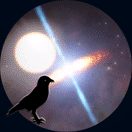 Star Engineer
Group: Local Moderators
 Germany
Germany
Messages: 1742
Status: Offline
| Quote Zefnoly (  ) Is it because im missing this in the script?
// ZendaSys.sc
// Autor: Zefnoly
No, these are just comments without function.
Post your 'universe.cfg'.
Don't forget to look here.

|
| |
| |
| Zefnoly | Date: Wednesday, 17.02.2016, 16:15 | Message # 63 |
 Space Tourist
Group: Users
 Pirate
Pirate
Messages: 38
Status: Offline
| Here is my universe.cfg
Code //////////////////////////////////////////////////
// SpaceEngine Universe configuration file //
//////////////////////////////////////////////////
StarsCatalogs // stars catalogs
(
//"catalogs/stars/Stars120k.dat" // main star catalog in dat format
"catalogs/stars/Stars120k.csv" // main star catalog in csv format
"catalogs/stars/Stars.sc"
"catalogs/stars/BinStars.sc"
"catalogs/stars/BlackHoles.sc"
"catalogs/stars/ExoPlanetsSuns.sc"
"catalogs/stars/Zenda.sc"
"catalogs/planets/ZendaSys.sc"
)
GalaxiesCatalogs // galaxies catalogs
(
"catalogs/galaxies/galaxies10k.sc"
)
ClustersCatalogs // star clusters catalogs
(
"catalogs/clusters/clusters_open_named.sc"
"catalogs/clusters/clusters_open.sc"
"catalogs/clusters/clusters_globular.sc"
//"catalogs/clusters/clusters_extragalactic.sc"
)
NebulaeCatalogs // nebulae catalogs
(
"catalogs/nebulae/nebulae_MilkyWay.sc"
//"catalogs/nebulae/nebulae_M33.sc"
)
PlanetsCatalogs // planets catalogs
(
"catalogs/planets/Stars.sc"
"catalogs/planets/BinStars.sc"
"catalogs/planets/BlackHoles.sc"
"catalogs/planets/SolarSys.sc"
//"catalogs/planets/SolarSys3000.sc" // Bonus:) Comment out SolarSys.sc and uncomment this
//"catalogs/planets/SolarSys30000.sc" // Bonus2:) Comment out SolarSys.sc and uncomment this
"catalogs/planets/SmallMoons.sc"
"catalogs/planets/Asteroids.sc"
"catalogs/planets/KuiperBelt.sc"
"catalogs/planets/AsteroidsSmall.sc"
"catalogs/planets/KuiperBeltSmall.sc"
"catalogs/planets/Comets.sc"
"catalogs/planets/ExoPlanets.sc"
"catalogs/planets/ExoPlanets-custom.sc"
"catalogs/planets/ExoPlanets-unconfirmed.sc"
)
// our home address (switched with Shift-h)
HomeGalaxy "Milky Way"
HomeStar "Sol"
HomeWorld "Earth"
// planetary system generator probabilities settings
ProbBinaryStar 0.50 // binary system probability - 50% of all systems
ProbTripleStar 0.11 // triple system probability - 11% of binary systems
ProbQuadrupleStar 0.22 // quadruple system probability - 22% of triple systems
ProbSolitaryWD 0.033 // probability of solitary white dwarf among all systems at the last octree level
ProbSolitaryNSP 0.00025 // probability of solitary neutron star among all systems at the last octree level
ProbSolitaryBHP 0.00003 // probability of solitary black hole among all systems at the last octree level
ProbCompanionWD 0.01 // probability of companion white dwarf among all binary systems
ProbCompanionNS 0.00005 // probability of companion neutron star among all binary systems
ProbCompanionBH 0.0000075 // probability of companion black hole among all binary systems
ProbBrownDwarf 0.025 // brown dwarf probability
ProbGasGiant 0.36 // gas giant probability
ProbHotGasGiant 0.012 // hot gas giant probability
ProbOceania 1.00 // Oceania -> Terra probability
ProbVenusClouds 0.66 // probability of opaque cloud layer on Hot and Warm Deserts
ProbTitanClouds 0.66 // probability of opaque cloud layer on Titans and Ice Worlds
RingsProbThin 0.2 // Probability of a thin/transparent rings (Jupiter-like)
RingsProbNarrow 0.2 // Probability of a narrow rings (Neptune-like)
RingsProbSparse 0.3 // Probability of a sparse rings (Uranus-like)
RingsProbContrast 0.2 // Probability of a hi-contrast color rings
// life probabilities settings
ProbLifeTerra 0.3 // probability of origin of life on terra
ProbLifeOceania 0.3 // probability of origin of life on oceania
ProbLifeDesert 0.02 // probability of origin of life on desert
ProbLifeIceWorld 0.05 // probability of origin of life on ice world (under ice)
ProbLifeTitan 0.1 // probability of origin of life on titan (exotic)
ProbLifeGiantOrg 0.01 // probability of origin of life on gas giant (floaters)
ProbLifeGiantExo 0.002 // probability of origin of life on gas giant (floaters)
ProbPanspEjectTerra 1.0 // Probability of organic life spores ejection on asteroid impact on terras (surface & ocean)
ProbPanspEjectOceania 0.01 // Probability of organic life spores ejection on asteroid impact on oceanias (ocean)
ProbPanspEjectDesert 1.0 // Probability of organic life spores ejection on asteroid impact on deserts (surface)
ProbPanspEjectIceWorld 0.005 // Probability of organic life spores ejection on asteroid impact on ice worlds (subglacial)
ProbPanspEjectTitanOrg 0.002 // Probability of organic life spores ejection on asteroid impact on titans (subglacial)
ProbPanspEjectTitanExo 1.0 // Probability of exotic life spores ejection on asteroid impact on titans (surface)
ProbPanspEjecGiantOrg 0.0001 // Probability of organic life spores ejection on asteroid impact on gas giants (atmosphere)
ProbPanspEjectGiantExo 0.0001 // Probability of exotic life spores ejection on asteroid impact on gas giants (atmosphere)
ProbPanspInsertTerra 0.1 // Probability of organic life spores insertion on asteroid impact on terras (surface & ocean)
ProbPanspInserOceania 0.2 // Probability of organic life spores insertion on asteroid impact on oceanias (ocean)
ProbPanspInsertDesert 0.04 // Probability of organic life spores insertion on asteroid impact on deserts (surface)
ProbPanspInsertIceWorld 0.001 // Probability of organic life spores insertion on asteroid impact on ice worlds (subglacial)
ProbPanspInsertTitanOrg 0.0003 // Probability of organic life spores insertion on asteroid impact on titans (subglacial)
ProbPanspInsertTitanExo 0.08 // Probability of exotic life spores insertion on asteroid impact on titans (surface)
ProbPanspInsertGiantOrg 0.05 // Probability of organic life spores insertion on asteroid impact on gas giants (atmosphere)
ProbPanspInsertGiantExo 0.05 // Probability of exotic life spores insertion on asteroid impact on gas giants (atmosphere)
LifeOrgAgeUni 0.60 // mean value of system age to develop unicellular organic life (in billion years)
LifeOrgAgeUniDisp 0.25 // dispersion of system age to develop unicellular organic life (in billion years)
LifeOrgAgeMulti 3.50 // mean value of system age to develop multicellular organic life (in billion years)
LifeOrgAgeMultiDisp 0.70 // dispersion of system age to develop multicellular organic life (in billion years)
LifeOrgAgeComplex 4.00 // mean value of system age to develop complex ground organic life (in billion years)
LifeOrgAgeComplexDisp 0.50 // dispersion of system age to develop complex ground organic life (in billion years)
LifeExoAgeUni 1.50 // mean value of system age to develop unicellular exotic life (in billion years)
LifeExoAgeUniDisp 0.40 // dispersion of system age to develop unicellular exotic life (in billion years)
LifeExoAgeMulti 4.50 // mean value of system age to develop multicellular exotic life (in billion years)
LifeExoAgeMultiDisp 1.00 // dispersion of system age to develop multicellular exotic life (in billion years)
LifeExoAgeComplex 6.50 // mean value of system age to develop complex ground exotic life (in billion years)
LifeExoAgeComplexDisp 1.50 // dispersion of system age to develop complex ground exotic life (in billion years)
// planets settings
PlanetMsiniResolve 0 // method to compute planet mass from M sin i: 0 - using actual or procedural inclination, 1 - average inclination, 2 - inclination of 90 degrees
PlanetSpecularWater 0.65 // specular spot brightness of the water/liquid surface
PlanetSpecularIceTerra 0.85 // specular spot brightness of the ice on terras
PlanetSpecularIceDesert 0.50 // specular spot brightness of the ice on deserts
PlanetSpecularIceTitan 0.10 // specular spot brightness of the ice on titans and iceworlds
PlanetSpecularIceSpace 0.03 // specular spot brightness of the ice on airless worlds
// stars settings
StarMaxAppMagn 10.0 // max apparent magnitude of procedural stars while looking from Solar system
StarRelicMinDist 3.0 // min distance from the Sun to procedural black holes, neutron stars and white dwarfs
StarGalaxyDensity 1.0 // procedural stars density in galaxies
StarClusterDensity 1.0 // procedural stars density in clusters
StarProcBifurcation false // enable procedural bifurcation of catalog stars
StarErrorLogLevel 0 // 0 - do not log the star catalog loading, 1 - log errors, 2 - log all
StarNCoronaTextures 10 // number of star corona textures
StarColorShift 0.0 // color shift ("+" red, "-" blue)
StarColorSaturation 1.0 // color saturation
StarFrustumClipFOV 30.0 // max frustum clipping FOV
// procedural star clusters settings
ClusterCatMaxAppMagn 8.1 // max apparent magnitude of catalog clusters while looking from Solar system
ClusterMaxAppMagn 8.1 // max apparent magnitude of procedural clusters while looking from Solar system
ClusterGlobDensity 1.0 // globular clusters density in galaxies
ClusterOpenDensity 70.0 // open clusters density in galaxies
ClusterGlobRadius 30.0 // globular clusters mean radius
ClusterGlobRadiusDisp 30.0 // globular clusters radius dispersion
ClusterOpenRadius 7.0 // open clusters mean radius
ClusterOpenRadiusDisp 5.0 // open clusters radius dispersion
ClusterGlobLum 60000.0 // globular clusters mean luminosity
ClusterGlobLumDisp 10000.0 // globular clusters luminosity dispersion
ClusterOpenLum 25000.0 // open clusters mean luminosity
ClusterOpenLumDisp 4000.0 // open clusters luminosity dispersion
// procedural nebulae settings
NebulaMaxAppMagn 8.1 // max apparent magnitude of procedural nebulae while looking from Solar system
NebulaDiffDensity 1.5 // diffuse nebulae density in galaxies
NebulaPlanDensity 2.0 // planetary nebulae density in galaxies
NebulaSNRDensity 3.0 // SNR nebulae density in galaxies
NebulaDiffRadius 3.0 // diffuse nebulae mean radius
NebulaDiffRadiusDisp 1.5 // diffuse nebulae radius dispersion
NebulaPlanRadius 0.001 // planetary nebulae mean radius
NebulaPlanRadiusDisp 0.01 // planetary nebulae radius dispersion
NebulaSNRRadius 0.1 // SNR nebulae mean radius
NebulaSNRRadiusDisp 0.2 // SNR nebulae radius dispersion
NebulaDiffLum 10000 // diffuse nebulae mean luminosity
NebulaDiffLumDisp 2000 // diffuse nebulae luminosity dispersion
NebulaPlanLum 10.0 // planetary nebulae mean luminosity
NebulaPlanLumDisp 2.5 // planetary nebulae luminosity dispersion
NebulaSNRLum 5.0 // SNR nebulae mean luminosity
NebulaSNRLumDisp 1.2 // SNR nebulae luminosity dispersion
// galaxies settings
GalaxyProcOrientation true // procedurally generate orientation if it is missing in the catalog
I'm sure the file locations are right, has double checked several times. Stil the star is the only thing showing up, but not the planets
A creature from a planet found far on the other side of Milkyway, found on a planet orbiting a gas giant.

|
| |
| |
| JackDole | Date: Wednesday, 17.02.2016, 16:28 | Message # 64 |
 Star Engineer
Group: Local Moderators
 Germany
Germany
Messages: 1742
Status: Offline
| Quote JackDole (  ) Then add in the 'universe.cfg' in the section:
'PlanetsCatalogs // planets catalogs'
the line:
Code
"catalogs/planets/ZendaSys.sc"
You have the file 'ZendaSys' registered in the wrong place!
I have corrected it.
Code //////////////////////////////////////////////////
// SpaceEngine Universe configuration file //
//////////////////////////////////////////////////
StarsCatalogs // stars catalogs
(
//"catalogs/stars/Stars120k.dat" // main star catalog in dat format
"catalogs/stars/Stars120k.csv" // main star catalog in csv format
"catalogs/stars/Stars.sc"
"catalogs/stars/BinStars.sc"
"catalogs/stars/BlackHoles.sc"
"catalogs/stars/ExoPlanetsSuns.sc"
"catalogs/stars/Zenda.sc"
)
GalaxiesCatalogs // galaxies catalogs
(
"catalogs/galaxies/galaxies10k.sc"
)
ClustersCatalogs // star clusters catalogs
(
"catalogs/clusters/clusters_open_named.sc"
"catalogs/clusters/clusters_open.sc"
"catalogs/clusters/clusters_globular.sc"
//"catalogs/clusters/clusters_extragalactic.sc"
)
NebulaeCatalogs // nebulae catalogs
(
"catalogs/nebulae/nebulae_MilkyWay.sc"
//"catalogs/nebulae/nebulae_M33.sc"
)
PlanetsCatalogs // planets catalogs
(
"catalogs/planets/Stars.sc"
"catalogs/planets/BinStars.sc"
"catalogs/planets/BlackHoles.sc"
"catalogs/planets/SolarSys.sc"
//"catalogs/planets/SolarSys3000.sc" // Bonus:) Comment out SolarSys.sc and uncomment this
//"catalogs/planets/SolarSys30000.sc" // Bonus2:) Comment out SolarSys.sc and uncomment this
"catalogs/planets/SmallMoons.sc"
"catalogs/planets/Asteroids.sc"
"catalogs/planets/KuiperBelt.sc"
"catalogs/planets/AsteroidsSmall.sc"
"catalogs/planets/KuiperBeltSmall.sc"
"catalogs/planets/Comets.sc"
"catalogs/planets/ExoPlanets.sc"
"catalogs/planets/ExoPlanets-custom.sc"
"catalogs/planets/ExoPlanets-unconfirmed.sc"
"catalogs/planets/ZendaSys.sc"
)
// our home address (switched with Shift-h)
HomeGalaxy "Milky Way"
HomeStar "Sol"
HomeWorld "Earth"
// planetary system generator probabilities settings
ProbBinaryStar 0.50 // binary system probability - 50% of all systems
ProbTripleStar 0.11 // triple system probability - 11% of binary systems
ProbQuadrupleStar 0.22 // quadruple system probability - 22% of triple systems
ProbSolitaryWD 0.033 // probability of solitary white dwarf among all systems at the last octree level
ProbSolitaryNSP 0.00025 // probability of solitary neutron star among all systems at the last octree level
ProbSolitaryBHP 0.00003 // probability of solitary black hole among all systems at the last octree level
ProbCompanionWD 0.01 // probability of companion white dwarf among all binary systems
ProbCompanionNS 0.00005 // probability of companion neutron star among all binary systems
ProbCompanionBH 0.0000075 // probability of companion black hole among all binary systems
ProbBrownDwarf 0.025 // brown dwarf probability
ProbGasGiant 0.36 // gas giant probability
ProbHotGasGiant 0.012 // hot gas giant probability
ProbOceania 1.00 // Oceania -> Terra probability
ProbVenusClouds 0.66 // probability of opaque cloud layer on Hot and Warm Deserts
ProbTitanClouds 0.66 // probability of opaque cloud layer on Titans and Ice Worlds
RingsProbThin 0.2 // Probability of a thin/transparent rings (Jupiter-like)
RingsProbNarrow 0.2 // Probability of a narrow rings (Neptune-like)
RingsProbSparse 0.3 // Probability of a sparse rings (Uranus-like)
RingsProbContrast 0.2 // Probability of a hi-contrast color rings
// life probabilities settings
ProbLifeTerra 0.3 // probability of origin of life on terra
ProbLifeOceania 0.3 // probability of origin of life on oceania
ProbLifeDesert 0.02 // probability of origin of life on desert
ProbLifeIceWorld 0.05 // probability of origin of life on ice world (under ice)
ProbLifeTitan 0.1 // probability of origin of life on titan (exotic)
ProbLifeGiantOrg 0.01 // probability of origin of life on gas giant (floaters)
ProbLifeGiantExo 0.002 // probability of origin of life on gas giant (floaters)
ProbPanspEjectTerra 1.0 // Probability of organic life spores ejection on asteroid impact on terras (surface & ocean)
ProbPanspEjectOceania 0.01 // Probability of organic life spores ejection on asteroid impact on oceanias (ocean)
ProbPanspEjectDesert 1.0 // Probability of organic life spores ejection on asteroid impact on deserts (surface)
ProbPanspEjectIceWorld 0.005 // Probability of organic life spores ejection on asteroid impact on ice worlds (subglacial)
ProbPanspEjectTitanOrg 0.002 // Probability of organic life spores ejection on asteroid impact on titans (subglacial)
ProbPanspEjectTitanExo 1.0 // Probability of exotic life spores ejection on asteroid impact on titans (surface)
ProbPanspEjecGiantOrg 0.0001 // Probability of organic life spores ejection on asteroid impact on gas giants (atmosphere)
ProbPanspEjectGiantExo 0.0001 // Probability of exotic life spores ejection on asteroid impact on gas giants (atmosphere)
ProbPanspInsertTerra 0.1 // Probability of organic life spores insertion on asteroid impact on terras (surface & ocean)
ProbPanspInserOceania 0.2 // Probability of organic life spores insertion on asteroid impact on oceanias (ocean)
ProbPanspInsertDesert 0.04 // Probability of organic life spores insertion on asteroid impact on deserts (surface)
ProbPanspInsertIceWorld 0.001 // Probability of organic life spores insertion on asteroid impact on ice worlds (subglacial)
ProbPanspInsertTitanOrg 0.0003 // Probability of organic life spores insertion on asteroid impact on titans (subglacial)
ProbPanspInsertTitanExo 0.08 // Probability of exotic life spores insertion on asteroid impact on titans (surface)
ProbPanspInsertGiantOrg 0.05 // Probability of organic life spores insertion on asteroid impact on gas giants (atmosphere)
ProbPanspInsertGiantExo 0.05 // Probability of exotic life spores insertion on asteroid impact on gas giants (atmosphere)
LifeOrgAgeUni 0.60 // mean value of system age to develop unicellular organic life (in billion years)
LifeOrgAgeUniDisp 0.25 // dispersion of system age to develop unicellular organic life (in billion years)
LifeOrgAgeMulti 3.50 // mean value of system age to develop multicellular organic life (in billion years)
LifeOrgAgeMultiDisp 0.70 // dispersion of system age to develop multicellular organic life (in billion years)
LifeOrgAgeComplex 4.00 // mean value of system age to develop complex ground organic life (in billion years)
LifeOrgAgeComplexDisp 0.50 // dispersion of system age to develop complex ground organic life (in billion years)
LifeExoAgeUni 1.50 // mean value of system age to develop unicellular exotic life (in billion years)
LifeExoAgeUniDisp 0.40 // dispersion of system age to develop unicellular exotic life (in billion years)
LifeExoAgeMulti 4.50 // mean value of system age to develop multicellular exotic life (in billion years)
LifeExoAgeMultiDisp 1.00 // dispersion of system age to develop multicellular exotic life (in billion years)
LifeExoAgeComplex 6.50 // mean value of system age to develop complex ground exotic life (in billion years)
LifeExoAgeComplexDisp 1.50 // dispersion of system age to develop complex ground exotic life (in billion years)
// planets settings
PlanetMsiniResolve 0 // method to compute planet mass from M sin i: 0 - using actual or procedural inclination, 1 - average inclination, 2 - inclination of 90 degrees
PlanetSpecularWater 0.65 // specular spot brightness of the water/liquid surface
PlanetSpecularIceTerra 0.85 // specular spot brightness of the ice on terras
PlanetSpecularIceDesert 0.50 // specular spot brightness of the ice on deserts
PlanetSpecularIceTitan 0.10 // specular spot brightness of the ice on titans and iceworlds
PlanetSpecularIceSpace 0.03 // specular spot brightness of the ice on airless worlds
// stars settings
StarMaxAppMagn 10.0 // max apparent magnitude of procedural stars while looking from Solar system
StarRelicMinDist 3.0 // min distance from the Sun to procedural black holes, neutron stars and white dwarfs
StarGalaxyDensity 1.0 // procedural stars density in galaxies
StarClusterDensity 1.0 // procedural stars density in clusters
StarProcBifurcation false // enable procedural bifurcation of catalog stars
StarErrorLogLevel 0 // 0 - do not log the star catalog loading, 1 - log errors, 2 - log all
StarNCoronaTextures 10 // number of star corona textures
StarColorShift 0.0 // color shift ("+" red, "-" blue)
StarColorSaturation 1.0 // color saturation
StarFrustumClipFOV 30.0 // max frustum clipping FOV
// procedural star clusters settings
ClusterCatMaxAppMagn 8.1 // max apparent magnitude of catalog clusters while looking from Solar system
ClusterMaxAppMagn 8.1 // max apparent magnitude of procedural clusters while looking from Solar system
ClusterGlobDensity 1.0 // globular clusters density in galaxies
ClusterOpenDensity 70.0 // open clusters density in galaxies
ClusterGlobRadius 30.0 // globular clusters mean radius
ClusterGlobRadiusDisp 30.0 // globular clusters radius dispersion
ClusterOpenRadius 7.0 // open clusters mean radius
ClusterOpenRadiusDisp 5.0 // open clusters radius dispersion
ClusterGlobLum 60000.0 // globular clusters mean luminosity
ClusterGlobLumDisp 10000.0 // globular clusters luminosity dispersion
ClusterOpenLum 25000.0 // open clusters mean luminosity
ClusterOpenLumDisp 4000.0 // open clusters luminosity dispersion
// procedural nebulae settings
NebulaMaxAppMagn 8.1 // max apparent magnitude of procedural nebulae while looking from Solar system
NebulaDiffDensity 1.5 // diffuse nebulae density in galaxies
NebulaPlanDensity 2.0 // planetary nebulae density in galaxies
NebulaSNRDensity 3.0 // SNR nebulae density in galaxies
NebulaDiffRadius 3.0 // diffuse nebulae mean radius
NebulaDiffRadiusDisp 1.5 // diffuse nebulae radius dispersion
NebulaPlanRadius 0.001 // planetary nebulae mean radius
NebulaPlanRadiusDisp 0.01 // planetary nebulae radius dispersion
NebulaSNRRadius 0.1 // SNR nebulae mean radius
NebulaSNRRadiusDisp 0.2 // SNR nebulae radius dispersion
NebulaDiffLum 10000 // diffuse nebulae mean luminosity
NebulaDiffLumDisp 2000 // diffuse nebulae luminosity dispersion
NebulaPlanLum 10.0 // planetary nebulae mean luminosity
NebulaPlanLumDisp 2.5 // planetary nebulae luminosity dispersion
NebulaSNRLum 5.0 // SNR nebulae mean luminosity
NebulaSNRLumDisp 1.2 // SNR nebulae luminosity dispersion
// galaxies settings
GalaxyProcOrientation true // procedurally generate orientation if it is missing in the catalog
Don't forget to look here.

|
| |
| |
| Zefnoly | Date: Wednesday, 17.02.2016, 16:47 | Message # 65 |
 Space Tourist
Group: Users
 Pirate
Pirate
Messages: 38
Status: Offline
| JackDole, Thank you! I'm just a little tired today. Should have looked trough the script for the actual place to have it....
A creature from a planet found far on the other side of Milkyway, found on a planet orbiting a gas giant.

|
| |
| |
| Zefnoly | Date: Wednesday, 17.02.2016, 19:00 | Message # 66 |
 Space Tourist
Group: Users
 Pirate
Pirate
Messages: 38
Status: Offline
| Well... Most of it is done (used some time to get the terrain formations i wanted on the planet)
Here you can see my planet with life orbiting close to the gas giant with my own star. (was able to make the planet have close to earth temp too)

My next step (if possible) is to export the terrain map and make a city light map above it on own layer to make it look like it got cities.
Oh... Also, before adding these two planets i made sure to export the planets that where made procedural to fill the rest of the system. One of the other gas giants appeared on same orbit but i removed that one. And then i'm going to add some more moons to this gas giant i made myself apart from the terra planet orbiting it.
A creature from a planet found far on the other side of Milkyway, found on a planet orbiting a gas giant.

Edited by Zefnoly - Wednesday, 17.02.2016, 19:00 |
| |
| |
| Zefnoly | Date: Wednesday, 17.02.2016, 20:32 | Message # 67 |
 Space Tourist
Group: Users
 Pirate
Pirate
Messages: 38
Status: Offline
| Ok... I think i went to far with this one...

A creature from a planet found far on the other side of Milkyway, found on a planet orbiting a gas giant.

|
| |
| |
| quarior14 | Date: Saturday, 27.02.2016, 13:31 | Message # 68 |
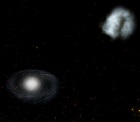 World Builder
Group: Users
 Pirate
Pirate
Messages: 649
Status: Offline
| Can we make custom textures for accretion disks and if so how ?
Quarior
|
| |
| |
| Himself | Date: Sunday, 20.03.2016, 03:50 | Message # 69 |
|
Astronaut
Group: Users
 United States
United States
Messages: 45
Status: Offline
| For some reason my stars are disappearing at distance. The first disappears at just under 4 light years. The system's luminosity is also listed in the info sheet at around 86 despite consisting of a black hole and a yellow dwarf of luminosity 0.97. The second star disappears at just over 2,000 AU.
Code StarBarycenter "Ageas"
{
RA 2.266424
Dec 36.794192
Dist 4208065951.23
}
StarBarycenter "Gargas barycenter"
{
RA 2.266424
Dec 36.794192
Dist 4208065851.23
Class "K5V"
}
Code Star "Ketu/Ageas A"
{
ParentBody "Ageas"
Class "G5V"
Age 4.49
Lum 0.97
Orbit
{
Period 765.99
SemiMajorAxis 200.32
Eccentricity 0.101
Inclination 42.23
AscendingNode 120.33
ArgOfPericenter 186.23
MeanAnomaly 26.29
}
}
Star "Rahu/Ageas B"
{
ParentBody "Ageas"
Class "X"
Radius 45.8
Age 4.49
Obliquity 42.72
Orbit
{
Period 765.99
SemiMajorAxis 12.85
Eccentricity 0.101
Inclination 42.23
AscendingNode 120.33
ArgOfPericenter 6.23
MeanAnomaly 26.29
}
}
Star "Gargas"
{
ParentBody "Gargas barycenter"
Class "K5V"
Age 5.52
Obliquity 42.72
Lum 0.17
Orbit
{
Type "Static"
}
}
|
| |
| |
| JackDole | Date: Sunday, 20.03.2016, 04:29 | Message # 70 |
 Star Engineer
Group: Local Moderators
 Germany
Germany
Messages: 1742
Status: Offline
| Quote Himself (  ) For some reason my stars are disappearing at distance.
I guess that has something to do with the great distance. If you take only about 4000 parsecs, instead of 4.2 billion parsecs, this does not happen.
The calculation accuracy of SE decreases at such great distances.
Here 'Ketu' is about 75 light-years away.
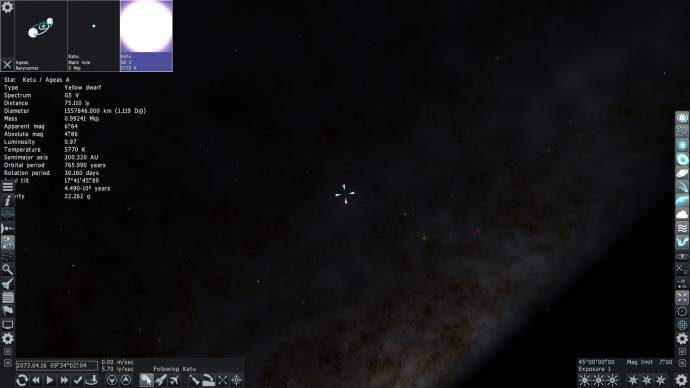
Don't forget to look here.

|
| |
| |
| Himself | Date: Sunday, 20.03.2016, 06:49 | Message # 71 |
|
Astronaut
Group: Users
 United States
United States
Messages: 45
Status: Offline
| Did not seem to help. I progressively moved the system until it was only about 6 parsecs away from Sol but it still disappeared. I even deleted the system and re-added it to see if that would fix it, but no dice.
|
| |
| |
| quarior14 | Date: Wednesday, 27.04.2016, 19:39 | Message # 72 |
 World Builder
Group: Users
 Pirate
Pirate
Messages: 649
Status: Offline
| There is a way to create a completely customized system ? I mean you put StarBarycenter but every time he put only a star, he is there a way for it to create multiple stars ? You say go to a planets.sc file but it does not generate random planets.
Quarior
|
| |
| |
| JackDole | Date: Thursday, 28.04.2016, 04:42 | Message # 73 |
 Star Engineer
Group: Local Moderators
 Germany
Germany
Messages: 1742
Status: Offline
| quarior14,
In the 'universe.cfg' is this line:
Code StarProcBifurcation false // enable procedural bifurcation of catalog stars
Set it to 'true'
Space Engine then creates multiple star systems for catalog stars.
You can use the attached script to test it. It creates a whole alphabet of wonderful star systems
This is 'Gelusa'
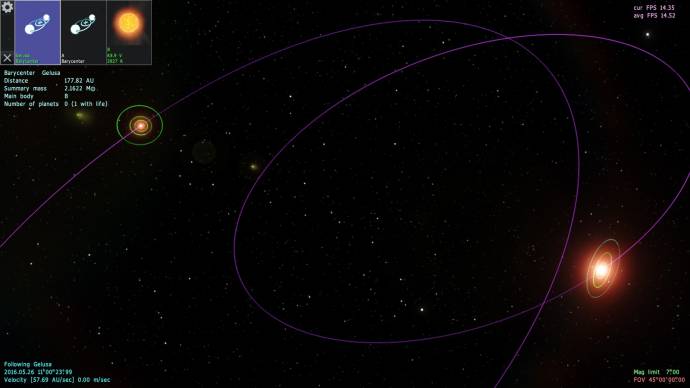
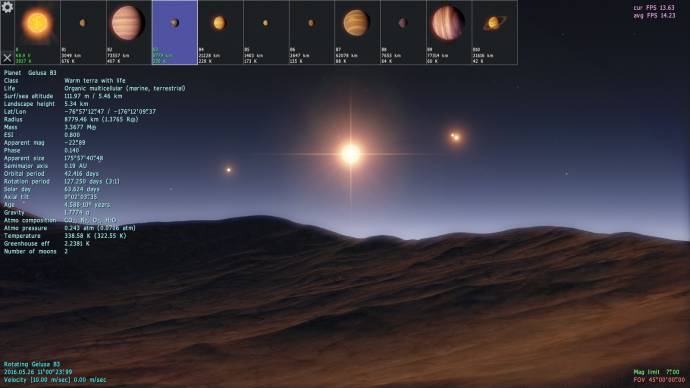
The system may be different with you.
Don't forget to look here.

Edited by JackDole - Thursday, 28.04.2016, 04:44 |
| |
| |
| quarior14 | Date: Thursday, 28.04.2016, 12:06 | Message # 74 |
 World Builder
Group: Users
 Pirate
Pirate
Messages: 649
Status: Offline
| JackDole, thanks you.
Quarior
|
| |
| |
| Ostarisk | Date: Tuesday, 03.05.2016, 22:06 | Message # 75 |
 Pioneer
Group: Users
 Australia
Australia
Messages: 451
Status: Offline
| If only there was a way to put it in another galaxy without trying to figure out where the galaxy is in space...

My mods
|
| |
| |